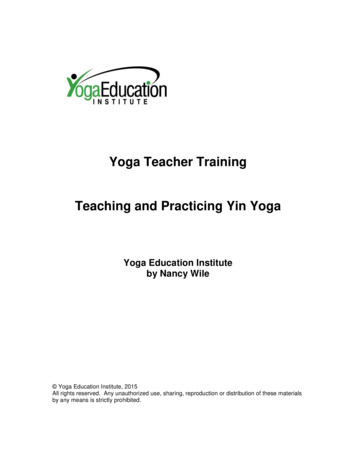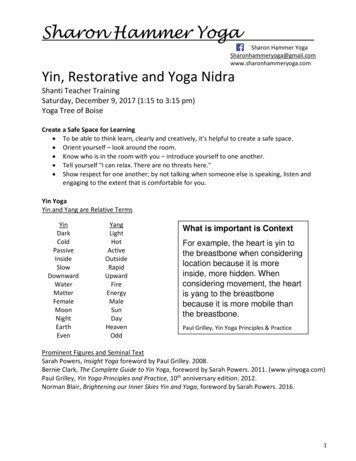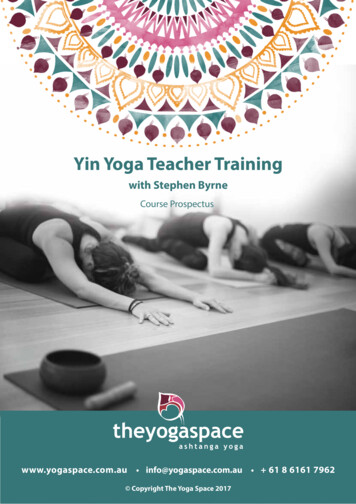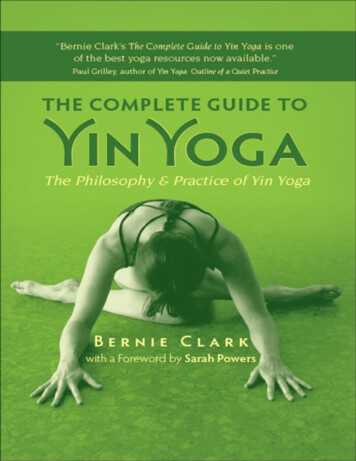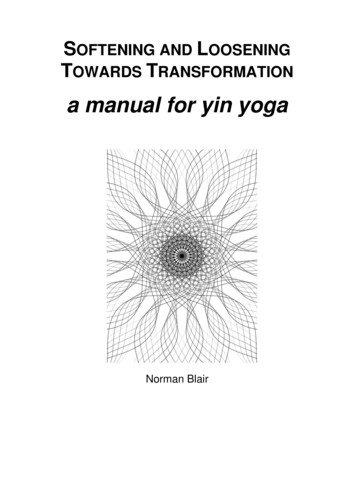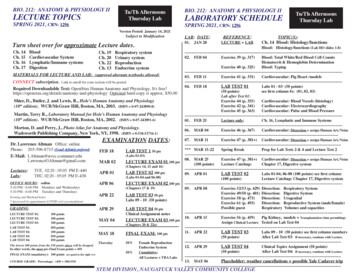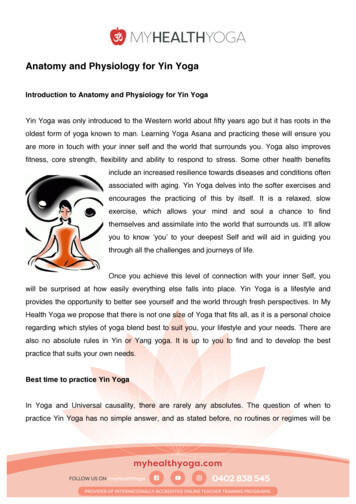
Transcription
Anatomy and Physiology for Yin YogaIntroduction to Anatomy and Physiology for Yin YogaYin Yoga was only introduced to the Western world about fifty years ago but it has roots in theoldest form of yoga known to man. Learning Yoga Asana and practicing these will ensure youare more in touch with your inner self and the world that surrounds you. Yoga also improvesfitness, core strength, flexibility and ability to respond to stress. Some other health benefitsinclude an increased resilience towards diseases and conditions oftenassociated with aging. Yin Yoga delves into the softer exercises andencourages the practicing of this by itself. It is a relaxed, slowexercise, which allows your mind and soul a chance to findthemselves and assimilate into the world that surrounds us. It’ll allowyou to know ‘you’ to your deepest Self and will aid in guiding youthrough all the challenges and journeys of life.Once you achieve this level of connection with your inner Self, youwill be surprised at how easily everything else falls into place. Yin Yoga is a lifestyle andprovides the opportunity to better see yourself and the world through fresh perspectives. In MyHealth Yoga we propose that there is not one size of Yoga that fits all, as it is a personal choiceregarding which styles of yoga blend best to suit you, your lifestyle and your needs. There arealso no absolute rules in Yin or Yang yoga. It is up to you to find and to develop the bestpractice that suits your own needs.Best time to practice Yin YogaIn Yoga and Universal causality, there are rarely any absolutes. The question of when topractice Yin Yoga has no simple answer, and as stated before, no routines or regimes will be
suitable for everyone. You should exercise trial and error and get to know yourself better to findthe best routine for you. However, in an attempt to simplify this exercise, the following are a fewsuggestions about when to practice Yin Yoga: When our muscles are cool so they don’t steal the stress away from the deeper tissues e.g.early in the morning. Later in the evening before bed to calm the mind before sleep. Before an active Yang practice, before the muscles become too warmed up. When life has become very busy, to balance the yang energies in our environment. After a long trip as traveling is very yang, even if we are sitting down most of the time. During a woman’s menstrual cycle, to preserve energy. During injury-recovery or time of illness.How deep should we go in a posture?Considering that we are all different, there is no set rule for everyone. However, we should workwithin the limits of the tissues activated so as not to move into the injury realm. When weexercise, we stress our tissues to make them weaker initially; once we release the stress, thetissues recover and become stronger. If we apply too much stress, or hold for too long, or do notallow enough rest, we are risk of injuring ourselves.How long should Yin postures be held?Yoga in general promotes the awareness, discerning and release of Ego inputs, not only in yourYoga practice, but also in your daily life.Yin Yoga encourages letting go of comparingourselves to others, as this will often lead to injury. Once we are able to accept that we are alldifferent, in different journeys and stages, and have been blessed with unique traits andqualities, we understand that we shouldn’t do someone else’s practice. This includes yourteacher’s practice or the person next to you who may seem proficient in Yoga Asana. In otherwords, what might work for a friend could be dangerous for you. Allow yourself time to open upYIN YOGA TEACHER TRAINING ANATOMY & PHYSIOLOGY FOR YIN YOGA PAGE 2 OF 19
and mould your body into a more Yin- like being. It may take you weeks, months or even yearsto reach your particular goals. If you are practicing on your own, the use of a stopwatch isrecommended.Traditionally Yin postures are held three to five minutes; however, if you are just beginning, youmay want to start with one or two minute holds and work your way toward longer periods. Youmay find that some postures allow you to remain in the pose longer than others; this is ok. Reset the timer and stay longer. Our bodies are not uniformly open either. We may find that oneside of our body is more flexible, strong or malleable than the other. This is normal. Ahimsa (dono harm) should always rule your practice, so remember- if you are struggling to remain in apose, come out regardless of whether the timer has sounded or not. Listen to your body andyour intuition and let go of Ego inputs to maximize the safety and efficacy of your Yin practice.How many times per week should we practice Yin yoga?In the yang world we are advised to rest our muscles for at least a day between workouts. Thereason for this is to allow the muscles a chance to repair the microscopic damage that occursduring workouts and to allow the metabolic waste products to be removed. In our yin practicehowever, the muscles are quiet and we do not metabolize our fuels, so there are few or nowaste products to get rid of. We do however, create microscopic damage to our connectivetissues, and we do want time to allow this to heal and become stronger. However studies haveshown that we do not have to wait days between practices to allow this healing to take place. Ahealthy and mindful practitioner could practice Yin Yoga every day. Remember: during busyperiods of time, a short practice is still better than no practice at all. Our intuition and bodies willlet us know when to rest and when to practice. Be mindful to find the right answers for you.YIN YOGA TEACHER TRAINING ANATOMY & PHYSIOLOGY FOR YIN YOGA PAGE 3 OF 19
Effects of Yin Yoga in the mindYoga, in general, is designed to create harmony in the body and the mind. In its purest form italso seeks to join your consciousness with the universe. The intention is to become spirituallyaware and gain a deeper understanding of the world around us, and how our interactions canchange the lives of those we meet. For this reason, unsurprisingly, people who practice Yinyoga appear to have a better attention span and a higher level of concentration. This is a directresult of the improved ability to relax and focus on what is important.There are three main aspects of the physiology of yoga and these hold true, regardless ofwhether you choose to practice Yin, Yang or both types of yoga: Flexibility. Yin Yoga focuses on the connective tissues in the body. These tissues are verystrong and relatively rigid; they will not respond well to bursts of energy attempting to changethem. The longer and more flexible these connecting tissues become, the better our ability willbe to stretch. On the other hand, Yang yoga focuses on bursts of movement; these quickrepetitive movements are perfect for building muscle tone. Conversely Yin yoga must applyslow, gentle pressure to the connecting tissues to allow them to slowly stretch. Attempting tostretch them by repetitive, quick movements, such as in Yang yoga, can cause injury. Pranayama. Breathing must go hand in hand with stretching. Activating muscles andconnective tissue will require more oxygen in the blood. Our ability to stretch and open up isdirectly linked with our respiration and the amount of blood oxygen at any given time.Pranayama is also directly linked with our emotional state, levels of stress and pain thresholds.In Yang’s explosive flows, muscles will require oxygenation in order to keep up and avoidexhaustion.In Yin we need oxygen to achieve a state of relaxation and nourishment forconnective tissue.The more relaxed we can be in a Yin posture, the more effectivelyconnective tissue will be targeted and the longer and safer we can be in a pose. De-stress. This is a very challenging practice for many Westerners but one of the mostYIN YOGA TEACHER TRAINING ANATOMY & PHYSIOLOGY FOR YIN YOGA PAGE 4 OF 19
important aspects of practicing Yin yoga. As we focus on our inner self and distance our mindfrom external world issues, we will be able to go into a deep, introspective state which will allowus to put many things into perspective. What appeared to be a disaster can be placed intocontext and a solution worked out. True relaxation of the body involves the use of meditation,which is something that the positions of Yin yoga are designed to encourage. Meditation simplyallows you to focus your thoughts on yourself, your relation to the world around you andultimately, a deeper understanding of yourself.Muscle tissue is YangOne of the basic characteristics of yang exercise is rhythmic movement. Yang forms ofexercise, (running, weight lifting, and swimming, dancing, martial arts, gymnastics, etc.),alternately contract and relax the muscles. Muscle tissues respond very well to rhythmic yangexercise. Most popular forms of yoga (Ashtanga, Vinyasa or power yoga) are yang as theyemphasize this rhythmic movement and muscular activation.Muscles are bundles of filaments filled with fluids, particularly water. Muscles can be up to 90%water during intense exercise. The elasticity of muscle tissue varies dramatically with its fluidcontent. Most yoga students like to warm up by doing a series of muscular standing postures orinversions, because working the muscles fills them with blood and makes them more elastic.Exercising muscles also helps bones stay healthy because when muscles vigorously pull onbones the bones respond by becoming thicker and stronger. This is why vigorous, not gentle,exercise is prescribed to prevent osteoporosis.Yang tissues do better when stressed in a yang manner and yin tissues do better whenstressed in a yin way. Stress has many negative connotations in our culture because we forgetto rest after it. But to have no, or little, stress in our life is just as damaging as having too muchstress. We need to stress the body, and we need to rest it. There is a yin/yang balance herethat leads to health. Too much of anything is not healthy.YIN YOGA TEACHER TRAINING ANATOMY & PHYSIOLOGY FOR YIN YOGA PAGE 5 OF 19
Yang exercise targets the yang tissues: the muscles. Muscles thrive when rhythmically andrepetitively moved. Any static holds are brief. The muscles are elastic and can take this type ofexercise. However, to apply yang exercise to yin tissues could damage them. Yin tissues, beingmore plastic, require gentler but long-held stresses. To rhythmically bend ligaments over andover again, as some students do when doing drop back from standing into the Wheel or movingfrom Up-dog to Down-dog, can, over time, damage the ligaments. The point here is do not applyyang exercise techniques to yin tissues.Applying a yin exercise to yang tissues could also be damaging. Holding a muscle in acontracted state for a long period of time is called “tetany” and may damage it.Connective tissue is YinYin exercises create a gentle traction of the connective tissue. Asimportant as it is for our physical and mental well-being to be strong, itis not muscular strength that gives us the feeling of ease and lightnessin the body; it is the flexibility of the joints. It’s interesting to point outthat most professional athletes don’t retire because of muscularproblems; they retire because of joint problems. Bad ankles, badbacks, bad knees, etc., are the injuries that force athletes to retire and old people to livesedentary lives.Yin yoga postures gently stretch and rehabilitate the connective tissues that form our joints.Most people accept the fact that muscle tissue shrinks or grows in response to exercise butimagine that the connective tissues of the body are inert and unchanging. This is largely untrue,YIN YOGA TEACHER TRAINING ANATOMY & PHYSIOLOGY FOR YIN YOGA PAGE 6 OF 19
as all tissues of the body are changing and adapting to the stresses put upon them. If we neveropen our hips, bend our knees or stretch our spines, the connective tissue is going to shorten tothe minimum length needed to accommodate our regular movements. Years of abuse andneglect such as living sedentary lives or exercises that lead to many injuries (both extremes ofthe excess-deficiency spectrum) will lead to contraction and stiffness because our joints willhave been shrink-wrapped by the shortened connective tissue.Yin Yoga is an invaluable true anti-aging tool. If we want to maintain our joints flexible, we mustexercise them. We should not exercise them like muscles; we must exercise them in a yinway. Moderately stretching the joints does not injure them anymore than lifting weights injuresthe muscles. Both forms of exercise can be done carelessly, but neither is innately wrong ordangerous. Of course, if someone bounces into their joints they will hurt themselves sooner orlater, but bouncing is a yang activity, and yin connective tissue shouldn’t be trained that way.Many health care professionals dismiss the idea of exercising joints as they have themistaken view that all exercise is yang exercise. Despite this concern it is possible, and in factnecessary, to exercise ligaments, bones, and joints in a yin way. And remember the importanceof resting our bodies after both a Yin or Yang session.“Our teeth, for example, are anchored in bone and appear to be immobile. We know fromexperience, however, that they change. Still, no one would think it viable to “exercise the teeth”by grabbing hold of them and wiggling them back and forth as in yang activity. But with patient,methodical use of braces and retainers, even our teeth can be moved and realigned. Likewisethe connective tissues that form our joints can be safely and desirably “exercised” by gentlystretching them in yin yoga postures.” (Hiroshi Motoyama)YIN YOGA TEACHER TRAINING ANATOMY & PHYSIOLOGY FOR YIN YOGA PAGE 7 OF 19
Yin Yoga at the quantum levelBy now we hope to have conveyed the basic idea that connective tissues do not respond torhythmic stresses the way muscles do. Connective tissues resist brief stresses but slowlychange when a moderate stress is maintained for three-to-five minutes. However to furtherclarify what happens inside our bodies, we can observe natural phenomena. When we applyheat to a number of materials they become malleable. Even the hardest of materials such asmetals, stones, diamonds, plastics, etc. can be softened or even liquefied under the righttemperatures. Heat is a form of energy. When we add heat to something what we are doing atthe atomic level is increasing its resonance. The atoms start vibrating and spinning at a higherspeed and we feel this as heat. This vibration and spinning causes a state of fluidity andmalleability in which materials can be bent and reshaped easily, as opposed to broken orcracked.This is known as a “Phase change”. Within our bodies, holding a stress on connective tissue forseveral minutes creates a phase change in its fluids, which results in a lengthening of the tissueand a feeling of ease. This phase change also allows a greater movement of Chi/Prana andblood, which transfers heat and nutrients through the tissues, which is both pleasurable andpromotes healing. Someone new to yoga will probably experience a phase change during aposture but the physical lengthening might not be very profound. In other words, they willexperience a pleasant energetic release even if they do not sink much deeper into the pose. Butwith persistent practice the fibres of connective tissue will grow and realign to allow for a greaterrange of motion as well.YIN YOGA TEACHER TRAINING ANATOMY & PHYSIOLOGY FOR YIN YOGA PAGE 8 OF 19
Yin Postures & RelaxationTo stress the connective tissue around a joint, the muscles must be relaxed. If the muscles aretense then the connective tissue doesn’t take the stress. “You can demonstrate this for yourselfby gently pulling on the middle finger of your left hand. When the left hand is relaxed you canfeel the connective tissue of the finger joint stretching at the joint nearest the palm. When thefingers of the left hand are tensed and extended you can feel the muscles resist the pull, but theconnective tissue is not being stretched. The stretching of the knuckle may seem a trivialexample but the same principle applies to the knees, hips, and spine: the muscles in theseareas must be relaxed if the connective tissue is to be stressed when doing a pose. Note that itis not possible or even desirable for all the muscles of the body tobe relaxed when doing yin poses, but the muscles in the target areamust be relaxed. For example, in a forward bend you may want togently pull with your arms or contract your abdomen to increase thestress along the spine. But the muscles along the spine must berelaxed or the connective tissue will not be stretched.” (SarahPowers)In conclusion, Yang styles of yoga generally target the muscles andemploy rhythmic, repetitive movements to stress the fibres andcells of the muscles. Being elastic and moist, the musclesappreciate this form of exercise and respond well to it. Yin tissues, however, being drier andmuch less elastic, could be damaged if they were stressed in this way. Instead, our more plastictissues appreciate and require gentler pressures, applied for longer periods of time, in order tobe stimulated to grow stronger.The Yin within Yang & the Yang within YinRemember the white and black dot within the yin andyang symbol? Within yang there is yin and viceversa, this also applies to our tissues. Consider themuscle, which we just described as a yang tissue.YIN YOGA TEACHER TRAINING ANATOMY & PHYSIOLOGY FOR YIN YOGA PAGE 9 OF 19
Within our yin tissues, we also find yang elements. In our fascia and ligaments, which arepredominantly yin-like, there are contracting fibres, just like within our muscles. We also findelastic fibres called elastin within our yin tissues. So there is yang within yin here too; ourconnective tissues can contract and shorten.“Physiologically, through our yoga practice, we build stability and mobility. If we look atthe arc of aging, which everyone follows albeit at faster or slower rates, we begin life completelyyang-like: we have the ultimate mobility that we will ever have, but we have no stability.Newborn babies have to be handled carefully because they have no internal stability. Now westart to stiffen, to become more yin-like. We gain stability as we age. When we are youngsters,we don’t need to work on gaining more mobility because we are already so yang-like: we needto work on our muscles and gaining strength. This is a yang time of life so we need yang formsof exercise. Somewhere around our mid-twenties to mid-thirties we reach the optimal balancebetween yin and yang, between mobility and stability. But the arc of aging must be followed: wecontinue to become more yin-like as we age. As we get older, as we get more yin-like, we needa yin form of exercise to keep us mobile.” (Sarah Powers)Tissues in the human bodyOur physical bodies are made up of many types of tissues that respond differently to exercise.To fully understand the physiological benefits of Yin Yoga, we need to understand the nature ofthese tissues. Tissues are simply aggregations of cells in our body that have a similar purposeand arrangement.Generally, there are four main kinds of tissues: Epithelia (skin, linings of our organs, etc.) Nervous Muscle Connective tissueYIN YOGA TEACHER TRAINING ANATOMY & PHYSIOLOGY FOR YIN YOGA PAGE 10 OF 19
Yoga most directly affects these last two, although it actually affects the whole body and all ofour tissues. Every time we move, we engage muscle to create the movement, and eachmovement stretches, twists, or compresses all the tissues in the area as well as areas fartheraway.Connective TissuesOur joint capsules and ligaments are part of a larger group of tissues known as connectivetissues, a broad term that refers to biological tissues that bind, support, and protect othertissues. Connective tissue is extra-cellular, which means the tissues are not cells in themselvesbut are the materials surrounding and between cells. Connective tissue responds to stimuli,reacts to keep the body healthy, and creates and maintains the matrix of the body.There are many and various cells found inside thebody. These include nerve cells, fat cells (adipose),blood cells (macrophages, plasma cells, mast cells,and lymphocytes), and blood vessels (capillaries).Weaving their way through all this are the fibressuch as collagen and elastin, which connect thetissues. Our connective tissue is what gives usshape and helps to restrain our movements.Bones are the most resistant to movement; cartilage is softer than bone and restrains ouractivities less. Ligaments, which bind bones together, also act to restrain movement dependingupon their location or arrangement surrounding a joint.In living bone there is a significant portion of both collagen and calcium salts. The mineral saltshelp us tolerate compression of the bone while the collagen helps us resist tension that wouldbend or break the bone. If the bone was made only of mineral salt and was subjected toextreme pressure, it would snap the way a dead tree branch breaks: cleanly. However, healthy,bone, with a high degree of collagen meshing, breaks more like a living branch of a tree. If youYIN YOGA TEACHER TRAINING ANATOMY & PHYSIOLOGY FOR YIN YOGA PAGE 11 OF 19
have ever tried to snap off a living branch you know that it bends, crumpling one side whilefraying the side away from the pressure.Ligaments and TendonsLigaments are similar in construction to tendons but theirfunction is to bind bones together (unlike tendons whichbind muscle to bone), usually supporting a joint. Unliketendons, ligaments come in a variety of shapes: cords,sheets, or bands. While tendons are generally white inappearance, ligaments can be darker due to theirmixture of elastic and finer fibres. Ligaments can bepliable and flexible in the directions where they are notbinding the body. These qualities make ligaments ideal for protecting joints, which may move ina variety of ways. Ligaments are tough, strong, and pliable, yet mostly inelastic.Yin Yoga & JointsOur joints can be seen simply as spaces between the bones where movement is possible.Stabilizing the joint are ligaments, muscles, and tendons, which bind the bones together.Generally, one of the muscles’ jobs is to protect the joint. Ifthere is too much stress on the joint, the muscle will tearfirst, then the ligaments, and then finally the joint itself maybecome damaged. In this regard, yang yoga is designed tonot stress the joint. This is why there is so much care takento align the body and engage the muscles correctly beforecoming into asanas in the yang practice. However, YinYoga is specifically designed to exercise the ligaments andto regain space and strength in the joints.Normally, joints allow movement of the body to occur and also provide support to the body.YIN YOGA TEACHER TRAINING ANATOMY & PHYSIOLOGY FOR YIN YOGA PAGE 12 OF 19
Muscles attached to the bones via tendons provide the force or leverage to move one bonerelative to another. Wrapping around the joint itself are ligaments that support and protect thejoint. Inside the joints may be found synovial fluids or cartilage, or both, depending upon thetype of joint and its function. Not all joints are meant to provide large ranges of motion. Some donot allow any movement at all. There are three basic kinds of joints: Fibrous joints, where the bones are held together by connective tissues. An example of thiskind of joint is the joining of the plates of our skull. No movement is desired here so thejoints are fibrous, held tightly together. Cartilaginous joints, where the bones are held together by cartilage and allow slightmovement. Examples of these kinds of joints are the pubic symphysis (where the two endsof the pubic bones are connected by cartilage) and between the ribs and their connection tothe sternum. Slight movement is allowed in all these areas but large ranges of movementare not desirable. Synovial joints, where there is a space (the synovial cavity) between the bones. This type ofjoint provides the greatest degree of movement in a variety of ways.Yoga does not try to increase the range of movement in all three kinds of joints; however, for acartilaginous joint that has grown too tight, Yin Yoga can help to restore the normal range ofmotion. Yin Yoga helps rebuild the synovial joints and even extend the current range of motion.The Spine"Yoga is the fountain of youth. You're only as young as your spine is flexible.” (B.K.S. Iyengar)The human spine undergoes changes and is not fully developed until the age of 10, when thelumbar curve finally assumes its full curve and adult shape. Humans are very peculiar amongvertebrates; we are the only true bipeds on the planet and also one of the least mechanicallystable creatures. From an architectural point of view it is clear that we have the smallest baseof support, the highest center of gravity, and the heaviest cranium in proportion to the total bodyweight, than any other mammal. The head is very heavy (about 4-5kg) and sits at the top of thisYIN YOGA TEACHER TRAINING ANATOMY & PHYSIOLOGY FOR YIN YOGA PAGE 13 OF 19
exquisite structure increasing the challenge to remain balancedand with good posture. Fortunately, the human spine providesthe best integral support possible for all areas of the upperbody. The spine has extraordinary capabilities of rigidity andalso plasticity; in other words, it can be flexible and have agreat range of motion (this is especially true on those whopractice Yoga), and at the same time provide structure andstability to all body parts.The spinal column is able to neutralize a combination of tensileand compressive forces to which we are subjected on a dailybasis by not only physical activity, but also gravity itself.When a baby is in the womb, gravity is almost negligible, as thebaby floats peacefully in amniotic fluid. Upon birth, gravity is feltwith full strength for the first time and this is when the earlyspine along with still developing bones, tendons and musclesmust immediately respond by growing and becoming strongand flexible.The vertebral column (backbone or spine) consists of 24 articulating vertebrae, and 9 fusedvertebrae in the sacrum and the coccyx. It is separated by intervertebral discs and it houses andprotects the spinal cord in its spinal canal.The upper 24 articulating vertebrae are grouped under the names cervical (7 vertebrae),thoracic (12 vertebrae) and lumbar (5 vertebrae), according to the regions they occupy.Cervical: 7 vertebrae (C1–C7)Thoracic: 12 vertebrae (T1–T12)Lumbar: 5 vertebrae (L1–L5)Sacral: 5 (fused) vertebrae (S1–S5)Coccygeal: 4 (3–5) (fused) vertebrae (Tailbone)YIN YOGA TEACHER TRAINING ANATOMY & PHYSIOLOGY FOR YIN YOGA PAGE 14 OF 19
Intervertebral discs (or intervertebral fibrocartilage) lie between adjacent vertebrae in thespine. Each disc forms a cartilaginous joint to allow slight movement of the vertebrae, and actsas a ligament to hold the vertebrae together. It also has the role of protecting the spinal integrityby serving as a cushion to absorb impact and external forces.Spinal MovementThere are four possible movements for the spine: Flexion, extension, rotation (axial rotation ortwisting), and lateral flexion (side bending). These four movements are performed over thecourse of daily life, and the spine will develop just enough flexibility and range of motion to beable to easily withstand habitual movements. Yoga provides an arena for the spinal column totruly shine. Yoga asana encompasses the four basic movements of the spine, usually gentlyand gradually pushing the boundaries that daily habits have created. The result, over time, isthe increased range of motion (ROM) and the angle of axial rotation that the spine can achievewithout injury. By doing this you will provide your whole skeleton with a more solid yet flexiblefoundation. You will be able to withstand physical stress, prevent injuries and naturally correctyour standing and sitting posture.When healthy and possessing all its normal curves, the spine acts like a spring. Every time weincrease the pressure on our body- for example, by walking or running- the spine flexes. Thecurves deepen and then release. If our spine was a straight rod, the stresses would fall inbetween the vertebrae, and the discs cushioning the vertebrae would wear out quite quickly. Ofcourse, the ligaments wrapping the spine also take some of the strain, but these are moreresponsible for taking the strain of passive activities such as sitting or standing. Our musclessupport the dynamic movement of the spine.All forms of yoga can help strengthen the back. Yin Yoga can help reestablish the normal rangeof motion of the lumbar ligaments as well; but remember everybody’s bones are different. Whenwe practice moving our spine through its full and natural ranges of motion, we should be awareYIN YOGA TEACHER TRAINING ANATOMY & PHYSIOLOGY FOR YIN YOGA PAGE 15 OF 19
of going too far. Be aware of pain or its precursors. Don’t stay in a pose when the sensations ofthe poses are too difficult for you to deal with. The essence of the yin practice is to maintain agentle but persistent pressure for a long period of time.Additional Physiological Benefits of Yin YogaIf we consider the joints and bones being targeted by Yin Yoga, we can describe at least threebig additional benefits for our wellbeing: Prevent or reduce contracture, where the ligaments and the joint capsule shrink and reducethe joint’s mobility. Avoiding degeneration within the bones, and reduce fixation, a condition that limits themovement of our joints, and thus prevents fusion, a permanent loss of mobility in the joint. Reduce osteopenia and osteoporosis, which are dangerous reductions in bone density.Metaphysical Anatomy and Physiology & Yin yogaNECK-Thedirectorofourvisionanddirection: Structurally, the only real meaning of the neck isthat it holds our head on. Anyti
YIN YOGA TEACHER TRAINING ANATOMY & PHYSIOLOGY FOR YIN YOGA PAGE 4 OF 19 Effects of Yin Yoga in the mind Yoga, in general, is designed to create harmony in the body and the mind. In its purest form it also seeks to join your consciousness
